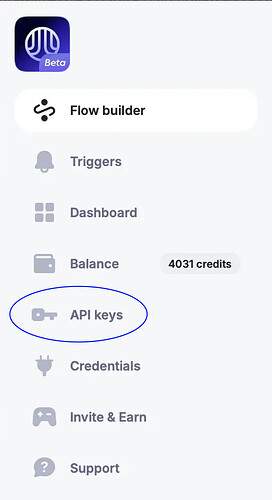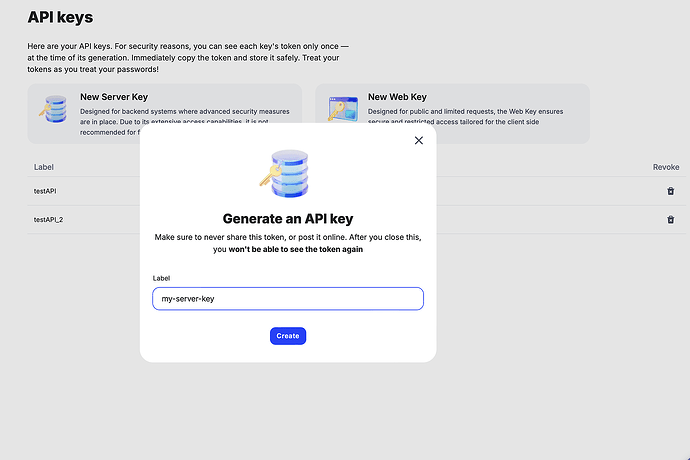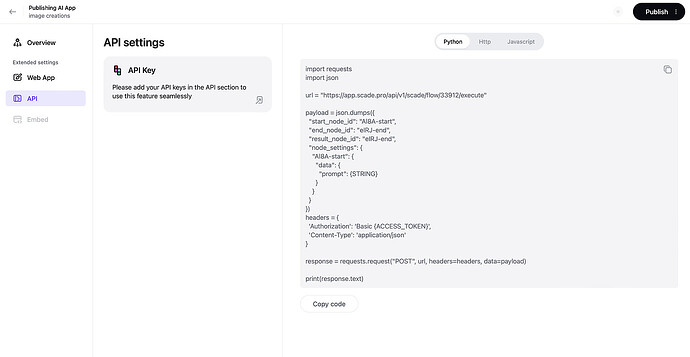You can customize an AI feature or an AI-based product with Scade and integrate it into your own application via API [Unified API] or create a solution using Shopify. In this tutorial, we’ll show you how to deploy any solution configured in Scade for end-users. We’ll be setting up both POST and GET requests to interact with your flow. Let’s get started!
Step 1: Getting Your API Server Key
To start, we’ll need to generate an API server key, which will allow authentication with the Scade API:
-
Go to the Scade main page.
-
Navigate to API Keys in the left menu.
-
Click on New Server Key and name it (e.g., “My Server Key”).
-
Once the token is generated, store it safely, as it won’t be accessible again.
Step 2: Publishing and Preparing the Flow
Next, we’ll prepare the flow you want to connect:
-
Navigate to your flow and click Publish (top-right corner).
-
Select API to see code examples for making POST requests in various languages, including Python, HTTP, and JavaScript.
Step 3: Review the API Documentation
Before setting up, review the API documentation:
- Click Knowledge Base (bottom-left corner) to access the documentation. API Documentation
- The documentation will guide you through making the initial POST call to execute the flow, followed by a GET request to retrieve the results.
Step 4: Connecting Scade API to Shopify with image generation flow
The guide is primarily based on information from sources [6] and [7], with some additional context from [5].
Please make sure to read the documents carefully on your own and don’t rely solely on the guide.
-
Create a Custom Shopify App
- Log in to your Shopify admin panel.
- Navigate to Apps > Develop Apps.
- Click Create an app.
- Name your app (e.g., “External Service Integration”).
- Go to API credentials and configure the necessary API scopes (e.g., read_products, write_products).
- Save your API key and secret key for later.
-
Set Up Your Development Environment
- Set up a Node.js project with your preferred framework (e.g., Express).
- Initialize a new Git repository.
- Create a .gitignore file to exclude sensitive information like API keys.
-
Install Necessary Dependencies
For a Node.js project, run the following commands to install essential packages:
npm init -y
npm install axios shopify-api-node express dotenv node-fetch
- Set Up Environment Variables
Create a .env file in your project root with the following keys:
SHOPIFY_SHOP_NAME=your-shop-name
SHOPIFY_API_KEY=your-api-key
SHOPIFY_API_SECRET=your-api-secret
SCADE_ACCESS_TOKEN=your-scade-access-token
- Create the Main Application File
In app.js, set up your basic server and routes:
require('dotenv').config();
const express = require('express');
const fetch = require('node-fetch');
const Shopify = require('shopify-api-node');
const app = express();
const port = 3000;
const shopify = new Shopify({
shopName: process.env.SHOPIFY_SHOP_NAME,
apiKey: process.env.SHOPIFY_API_KEY,
password: process.env.SHOPIFY_API_SECRET
});
app.use(express.json());
app.listen(port, () => {
console.log(`Server running at http://localhost:${port}`);
});
- Implement Integration Logic
This is the example of GET call answer
Please note that line 21 displays the name of the end node input you created in your flow.
{
"id": 2317569,
"data": {
"node_id": null,
"start_node_id": "Al8A-start",
"end_node_id": "eIRJ-end",
"result_node_id": "eIRJ-end",
"init_context": {},
"node_settings": {
"Al8A-start": {
"data": {
"prompt": "witch"
}
}
}
},
"status": 3,
"created": "2024-10-17T10:39:47.868836",
"finished": "2024-10-17T10:40:03.367300",
"result": {
"Result": "https://scade-uploads.s3.eu-central-1.amazonaws.com/uploaded-images/2024-10-17/d9cd723b3bf4867088127356d98c095efa77d956c1f0ada2395a1f3db610/R8_SD3_00001_.webp",
"inputs": null,
"data": null,
"success": {
"Result": "https://scade-uploads.s3.eu-central-1.amazonaws.com/uploaded-images/2024-10-17/d9cd723b3bf4867088127356d98c095efa77d956c1f0ada2395a1f3db610/R8_SD3_00001_.webp",
"inputs": null,
"data": null
}
},
"execution_time": 13901,
"execution_cost": 5.250145499850001,
"parent_id": null,
"ref_id": "flow:33912;",
"task_type": 4,
"is_hide": false,
"public_access_token": null,
"file_result_link": null
}
To execute the AI-generated image workflow, add the following functions to your app.js:
async function startJob(prompt) {
const headers = {
"Authorization": `Basic ${process.env.SCADE_ACCESS_TOKEN}`,
"Content-Type": "application/json"
};
const body = JSON.stringify({
"start_node_id": "Al8A-start",
"end_node_id": "eIRJ-end",
"node_settings": {
"Al8A-start": {
"data": {
"prompt": prompt
}
}
}
});
const response = await fetch("https://app.scade.pro/api/v1/scade/flow/33912/execute", {
method: 'POST',
headers,
body
});
const result = await response.json();
return result.id;
}
async function checkJobStatus(taskId) {
const headers = {
"Authorization": `Basic ${process.env.SCADE_ACCESS_TOKEN}`
};
const response = await fetch(`https://api.scade.pro/api/v1/task/${taskId}`, {
method: 'GET',
headers
});
return await response.json();
}
async function updateShopify(imageUrl) {
const product = await shopify.product.create({
title: 'AI-generated product',
images: [{ src: imageUrl }]
});
return product.id;
}
async function processJob(taskId) {
let jobComplete = false;
while (!jobComplete) {
const status = await checkJobStatus(taskId);
if (status.status === 3) {
jobComplete = true;
const imageUrl = status.result.Result;
await updateShopify(imageUrl);
return { imageUrl };
}
await new Promise(resolve => setTimeout(resolve, 5000));
}
}
- Create API Endpoints
Set up an endpoint to trigger the image generation:
Add this route to yourapp.js:
app.post('/generate-image', async (req, res) => {
const { prompt } = req.body;
const taskId = await startJob(prompt);
res.json({ message: 'Job started', taskId });
processJob(taskId).catch(console.error);
});
Final Steps: Testing, Deploying, and Monitoring
1. Test: Run your server and use Postman to send a POST request to http://localhost:3000/generate-image.
2. Deploy: Choose a hosting provider (e.g., Heroku, AWS) and deploy your app.
3. Monitor: Set up logs and monitoring to track the integration’s health.
By following these steps, you’ll successfully connect ScadePRO’s AI capabilities with Shopify, enabling dynamic product updates using AI-generated content.
Here’s a breakdown of the key contributions from each source:
[6] “Building a RESTful API with Node.js: A Step-by-Step Guide” provided the overall structure for the guide, including:
-
Initializing a new Node.js project
-
Installing required dependencies
-
Creating the server
-
Defining API routes
-
Integrating API routes into the server
[7] “Step-by-Step Guide to Creating a REST API in Node.js - Apidog” contributed:
-
The real-world REST API example for a library
-
The example of creating an Express app
-
The example of adding more routes for a “To-Do List” API
[5] “Integrating With Node.js REST APIs | Moesif Docs” provided additional context on working with Node.js REST APIs, though it wasn’t directly used in the step-by-step instructions.
This guide combines and adapts information from these sources to create a comprehensive tutorial on building a RESTful API with Node.js and Express.
Citations:
[1] Shopify API, libraries, and tools
[2] 7 Tips to Maximize Your Use of The Shopify API - Shopify
[3] https://www.youtube.com/watch?v=muhtIHD5vCo
[4] Comprehensive Guide to Third-Party API Integration in Shopify Application Development
[5] Integrating With Node.js REST APIs | Moesif Docs
[6] Building a RESTful API with Node.js: A Step-by-Step Guide - DEV Community
[7] Step-by-Step Guide to Creating a REST API in Node.js
Feel free to ask your questions and share insights about implementing Scade Flow into Shopify in this thread.



